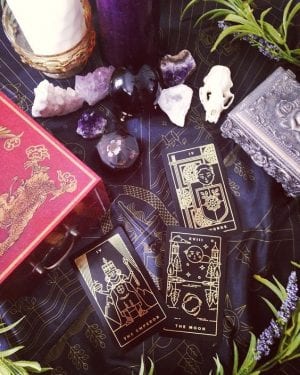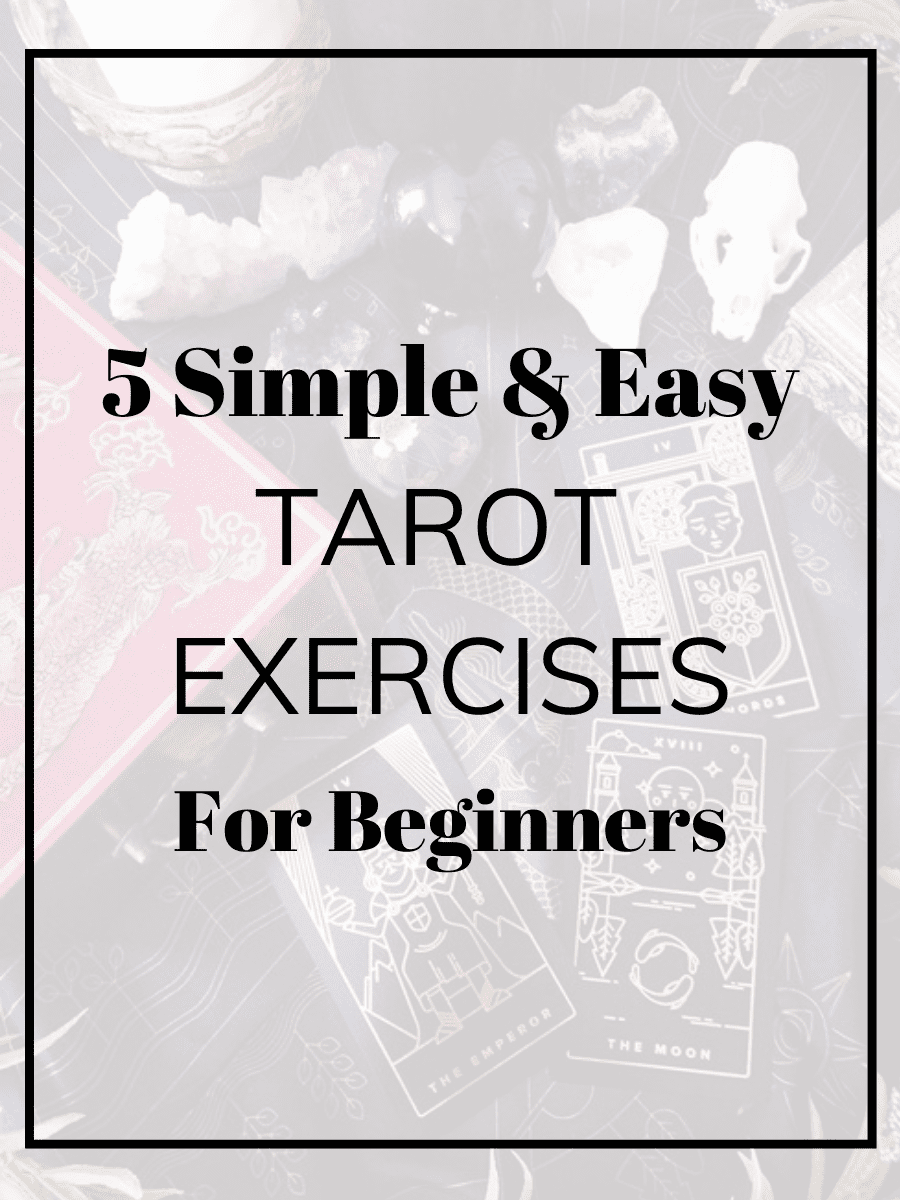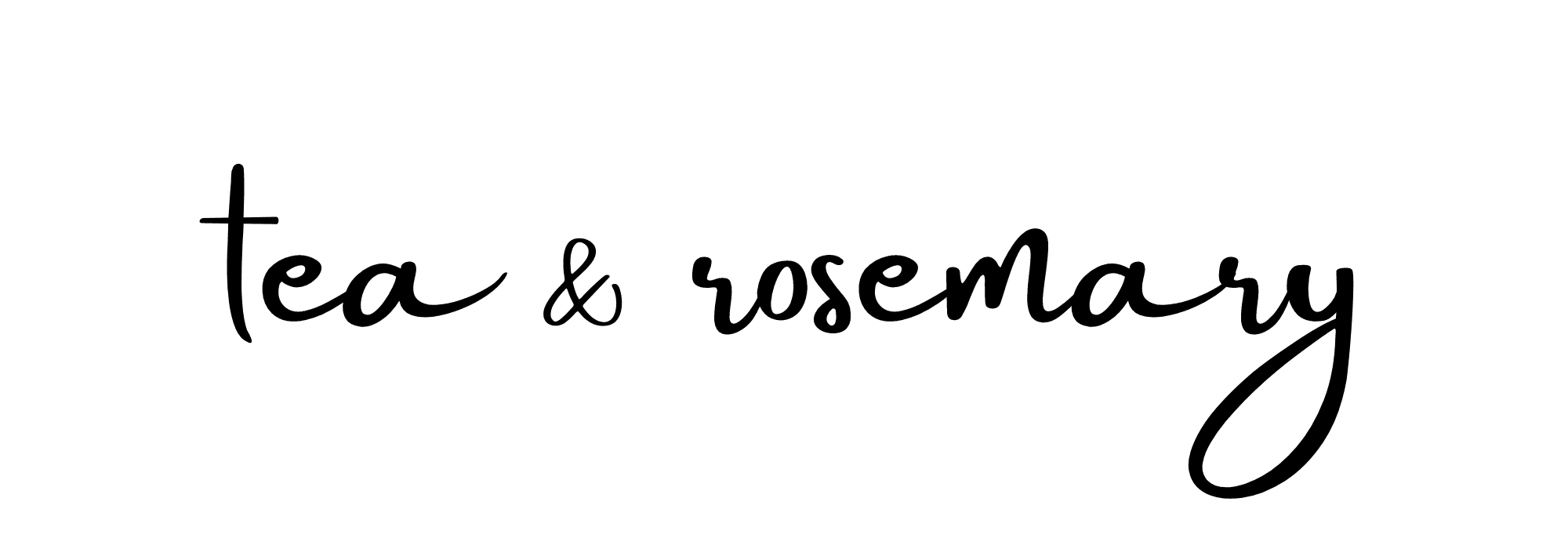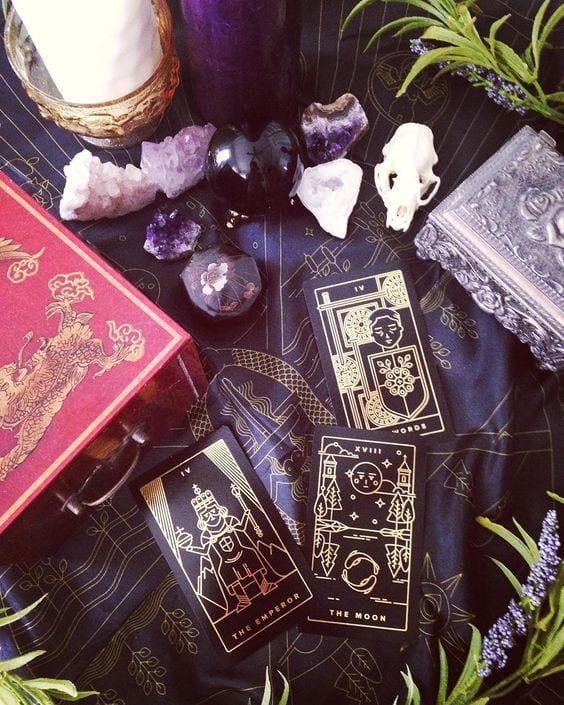
There are 78 cards in a typical Tarot deck. That’s a lot of different meanings to memorize! Not only do you have to know the definition and different applications of each of the card, but you have to know what they mean reversed as well. You can’t just read one card the same in every reading; you have to actually apply it to the situation.
It seems crazy hard, but this post will hopefully break it down and give you some easy steps to get started without becoming overwhelmed.
Sourcing the Definitions
Before you get started with any exercises, you need a reliable method to find definitions for each card. They won’t just pop into your head randomly – you’ll need to learn each definition (usually by reading it).
If you have the Rider Waite deck (which is by far the best deck for beginners), then I recommend using Llewellyn’s Rider Waite Book. It’s pretty small and is perfect to keep on hand for any reading. Having something tangible always works better for me than doing research on the computer, although I spent my first year doing Tarot looking up definitions online.
If you do choose to go the online route, Biddy Tarot is by far the best site for definitions. Alternatively, if you find that many of these definitions aren’t working for you, try Aeclectic. It’s a slightly older site so it isn’t updated very often (and makes it much harder to source reversed meanings), but it’s a good second option.
Before you start any of these exercises, you’ll want to have some source containing good definitions ready to go.
Use Only a Portion of the Deck
Separate the Major Arcana, Minor Arcana, and Court Cards. When you’re first beginning, I’d recommend using only the Major Arcana for any of these exercises. Once you’ve mastered those (or have a decent grasp on them), switch to the next group.
If you feel compelled to start learning with any one of these three groups, then start with that portion of the deck. There is no right or wrong here – this is just a simple way to help you learn the definitions and flavor of your readings. It’s way too difficult using the whole deck right off the bat, and you’ll definitely get discouraged.
When first beginning, I would practice at least a few times a week (doing a few exercises at a time) until I was really comfortable with one section of the deck. I would then move onto the next, but throw in a few exercises for the first portion so that I wouldn’t forget the definitions.
Interested in a full online tarot reading?
Click here to check out our shop page and browse readings as low as $8!
Clearing and Setting Your Intentions
Before beginning, I always shuffle my deck until it feels clear of any past energy. I also ask my spirit guides (whoever you speak to, pray to, or believe in will work!) to bring me answers for my highest purpose.
Anytime you ask a question to the deck, even if you’re just practicing, you want it to be something you can really use guidance on, or the deck won’t give you an answer. It shouldn’t be something you already know completely or don’t care about.
There should be enough energy surrounding the question that you actually feel compelled to know the answer, although the question doesn’t have to be super intense (I’ve asked about how my vacation will go, how I can schedule my week out, how I should approach decorating my home, if I should reconnect with an old friend, etc).
There’s always something you don’t know that you could use some guidance on! The cards are always right – even if the definition doesn’t seem to fit at first, trust that there’s something important in the card and keep researching different meanings of it. Alternatively, look to the colors, picture, or the general name of the card and see if you feel a purpose.
Exercise 1: Ask Simple Question With One Card
Spend 20 minutes asking simple questions and pulling one card to answer your question. Use reversals if that’s the way the card is flipped. Research the card until you find an answer that really feels right to you.
These questions can be literally anything you might want to know! It’s best to ask open-ended questions, since sometimes the Universe can’t give you a straight up yes or no, and you need advice instead. Some examples include:
- Which of my personality traits attract people to me?
- How can I strengthen my relationship with _____?
- What obstacle must I overcome to ______?
- How can I manifest more wealth in my life?
- How can I best manifest a healthier lifestyle?
- What can I do to boost my energy levels?
- Am I currently aligned with my soul’s purpose?
- What will bring my closer to my soul’s purpose?
- How can I advance in my career?
- What is one thing I’m learning right now?
- What is one thing that will change in the next month/year/decade?
- What is my greatest strength or weakness right now?
- How can I best overcome this issue in a relationship?
- What is my current attitude towards finances? How did I develop that attitude?
- How can I develop my psychic abilities?
The possibilities are unlimited. This is a great first exercise to learn one card at a time without any interference between the cards.
Another simple question to ask is: “What is in store for me today?” This is a daily exercise that you can do in the morning and reflect back on at night.
Exercise 2: A Basic 3-Card Spread
Once you get the hang of a set of cards individually, you want to start trying a 3-card spread so that you can see how the cards interact and relate to each other.
The questions that you’ll want to ask will be similar to the examples above. Virtually any question will work as long as the energy is strong enough (you actually want to know the answer) and it’s open-ended.
Her are some examples of great 3-card spreads to start with:
- Past / Present / Future
- My physical state / My emotional state / My mental state
- Mind / Body / Spirit
- What I aspire to? / What is standing in my way? / How can I overcome this?
- What do I need most? / What’s blocking me? / How do I remove the block?
- Strengths / Weaknesses / Advice
- What to be mindful of today / What to embrace today / Overall theme of the day
- Who I think I am / Who others think I am / Who I truly am
- Who I am / Who the other person (in a relationship) is / What the relationship is like right now
- Option 1 / Option 2 / Key information that will help you make a decision
Exercise 3: Choose a Card For a Character or Celebrity
For this exercise, you’ll want to choose a character from a show, movie, or book, or a celebrity, politician, author, etc. It should be someone who you really like or think is interesting! You need to have enough of a connection to this character or person to do this exercise accurately.
Next, you’ll shuffle the deck and ask your spirit guides (or whoever you communicate with) to give you a card that describes some facet of this person or their situation.
Pull one card (or more if it feels right, although I usually start with one) and see if you can figure out how the card relates to the person/character and why you may have gotten it.
For example, I recently chose Harry Potter. I got the Wheel of Fortune card, which I interpreted to mean that the Universe (or at least J.K. Rowling’s universe) is always working for him, not against him, and that everything is happening to teach him something. This card felt right to me, but I easily could have pulled something different. Death, The Magician, Strength, and even The Devil would all fit, among others.
This is a fun exercise because you can do it over and over with different characters or celebrities!
Exercise 4: Pairing Tarot With People You Know
This exercise is super easy and fun if you’re not feeling too serious!
Shuffle the cards and lay out three at random. You now have to pair each of these three cards up with someone you know. You can include literally anyone (from your close family members to someone you met a few times many years ago) as long as the character traits fit.
Try to feel the energy of the card and accurately match it with a person. If you don’t know the energy super well, then look up a full definition to get a taste of it before pairing the card. Make sure to take note of reversals and pair those accurately as well.
While this exercise works well with any group of cards or with a full deck, it’s especially helpful for when you’re trying to learn the Court Cards! Each Court Card signifies a person (with full on personality traits) so they’re easy to pair up; this is a helpful way to learn and remember the personalities of the Court Cards.
Exercise 5: Read For Someone Else
While you might not want to give full-on readings as a beginner, it can be helpful to interpret situations that aren’t entirely yours. I recommend asking close family members and friends if they’re okay with you using their general situations (such as work, relationships, etc.) I only ask people I’m super close with or people who are really open to this type of work – some people don’t want Tarot readers knowing their personal business or get freaked out by metaphysical stuff.
I personally practice with my parents, siblings, and fiance. They all love Tarot and don’t care if I know anything extra about them – in fact, they generally love when I have a new bit of insight for them.
If you don’t have anyone to practice on, try working with the energy of your pet or plant. They all have vast spirits with their own wants and needs!
Now that you have someone to work with, you’ll want to ask a question about a situation in this person’s life and pull 1-3 cards. Keep it simple (refer back to exercises 1 and 2) and read it just as you would for yourself, but try to interpret what the cards mean without any judgement.
It’s really hard to be a third-party and not bring your own views and biases to a reading. This exercise is not only helpful when you need to learn the cards, but also when you’re learning how to read intuitively rather than from your own viewpoints.
Make sure everything you get from the reading feels right. It can sometimes be helpful to say the key points out loud or write it down.
Moving From Beginner to Intermediate
Once you’ve mastered all of these exercises and generally know the definitions and meanings of most of the cards, you’re ready to move onto intermediate spreads and readings!
These basics really are so important to move forward. It’s hard to use your intuition when you’re struggling to remember the meaning of the card itself. Getting down these definitions and using the cards in a few simple but different ways is the place to start!



